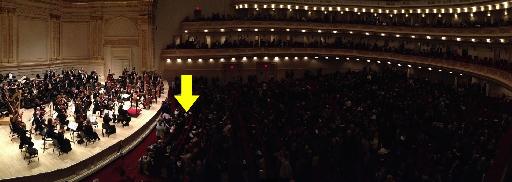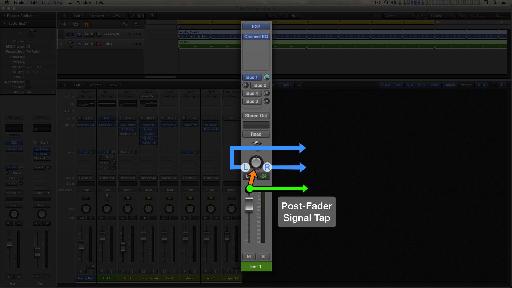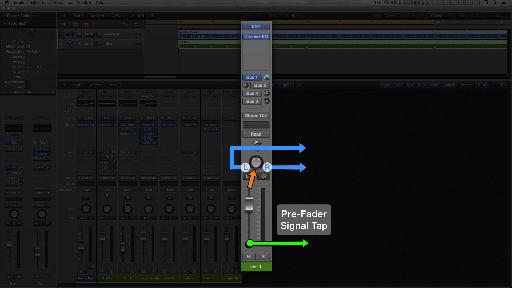我的灵感讨论的情况与几位作曲家谁寻求我对如何把监听器和样品的直接声音之间距离越远的意见后,写了这篇文章。换句话说,他们的最终目标是模拟一个管弦乐队听起来像从音乐厅中排在坐着一位听众的角度看,相对于前排甚至接近sourcethe导体或球员的位置。他们提出的解决方案:设置混响他们将是推子前而不是推子后。
现在,如果您选择不熟悉这些术语,不要担心。生病解释专业术语,以及这背后的工程方法的原则(这不会工作99%的时间,但我会到)。首先,让我们探索自然发生什么在音乐厅时,乐团被听到的距离。
在客房
当从一个音乐厅的舞台音响工程,它会立即开始reverberatereflecting关闭墙壁,天花板和地板和舞台上的乐器的直达声混合在。一般来说,混响本身的声音是声波的模糊,在较低的保真度和比直达声不太详细。进一步回你的房间,声音变得直接(干)声和混响声(湿)之间的平衡偏向潮湿的虚化。从坐在乐团更近或更远的效果是不是从只有几英寸远站在你的鼻子从一幅画,对比一下你几乎看,如果你把眼镜镜片磨砂太大的不同。
插图
插图B(故意模糊)
因此,当你想要的乐团被视为正在审理远离舞台,你想听到的那么直接的信号,更模糊的,模糊的混响。那是简单的,基本的原则。有两种结构工程方法,我们可以采取模拟这个:提高的混响产出水平会高于平时,或降低各干各的信号电平,并留下了混响的水平在哪里。无论哪种方式,其结果将是相同的:倾斜朝向湿湿/干平衡。
因此,如何将是设置发送是推子前可以实现这个目标呢?继承人的答案:在大多数情况下,它不能。如果有的话,你将同时混合推子这种做法将甩开你的干/湿平衡,尽快。并找出原因,让我们非常简要地回顾一下如何发送工作。
基本发送
传统的方法,用于将混响到多个声音中混合是从那些信道发送信号到一个公共的混响插件。做到这一点,当然,通过配置一个发送各信道,以管信号沿一公共总线到混响(见图1)。
图1:两个通道发送信号到一个公共的混响。
因此,有多少回响添加到声音(从技术上说,你发送到混响多少信号)是多少你打开了发送只是早晚的问题。但是否混响的量保持在一个部分的持续时间一致取决于如何从发送从获取其信号的信道内的精确点。而这正是整个推子前/推子后的事情来发挥作用。
分水点
图2:推子后信号抽头。
为将在硬件和软件调音台的默认配置为推子后,其中发送从水龙头点后信号的衰减器对声音(图2)的整体音量的影响。然而,其并不少见找到用于改变抽头点是推杆,其中,发送从一个点接收信号之前推子曾经有机会来影响水平(图3)的一个选项。
图3:推子前信号抽头。
用推子后发送,信号发送到混响量始终处于比例推子的水平。骑推子向上/向下意味着更多/更少的信号到达混响,分别。上攻这种安排是一致性:当您在混响的初始量表盘上的发送,不管你多么骑部分的音量,同时搅拌,干,湿信号始终处于比例彼此。这可以听到下面的音频片段,其中相同的中音长笛通道起着twicefirst用推子设置为零,然后用推子设置为-12分贝。
音频实施例1:
[音频ID =“33980”]
一致性的对立面
现在让我们想象一下会发生什么,如果调整推子对信号的量没有影响被发送到混响。例如,假设你有这样的持有太久,你想淡出它通过降低推子的一部分。如果衰减器对信号的电平没有影响被发送到动词,声音会连续地和直接地馈送信号到它,即使你完全淡出干信号。其结果是:你几乎不断听到混响效果的幽灵的声音,你淡出干信号后不久。
这可能会导致一个凉爽的效果,但它违背了初衷。所以,现在让我们无法想象的,但听到这是真的。在这第一个例子音频听到你会持续注意到推子后混响(和点击跟踪),持续太longtwo措施,而不是一个:
[音频ID =“33978”]
接下来,我已经褪色的长笛在同一小节的末尾,与混响发送设置推子后。干信号将被压制和声音击中混响将在混响环的唯一的最后一位。
[音频ID =“33979”]
现在听声音衰落以相同的方式,但是在那里的发送被设定为预推子。干信号的确会褪色,但经过一项措施是继续声音是纯粹的混响。
[音频ID =“33977”]
那推子前雅!
事实上,与推子前发送,当你调整推子你失去干,湿信号之间的平衡控制,当你移动推子。
当你提出推子发生相等,方向相反的问题。这里,干信号会得到更响亮,变得更直接无多大的声音回荡在房间的任何增加。这违背从特写声疏远听众的全部目的。你做出一个部分的响亮,效果是相同的物理移动该玩家或部分更接近收听者! (见图4)。
图4:用推子前发送提高推杆具有移动玩家更接近你的效果!
如何实现这一中间道声
这里的解决方案是很简单的。首先,不要理会推子前发送。让他们设置为推子后给你调整零件的水平,保持你拨打的发送旋钮的干/湿平衡的能力。为了实现一个多雨整体的声音,仿佛听者进一步从舞台,提高你的混响的输出电平(很容易做到),或降低所有的干信号(更难)的水平。 ID建议第一种方法。很简单!










 © 2024 Ask.Audio
A NonLinear Educating Company
© 2024 Ask.Audio
A NonLinear Educating Company
Discussion
BTW- LOVE all of your MPV videos!!!! 👌ðŸ½
The technique you mentioned is fodder for a whole series of articles. Or a book LOL! There are soooo many ways to control volume and dynamics, and depending on which one you use will determine its effect on the reverb balances and ultimately the mix. But regarding CC#11, it's not implemented i the same way in every sampled instrument. In EastWest Hollywood Strings, for example, CC#11 affects what we could call "true instrumental dynamics" because it's controlling sample crossfading. But in their EWQL Orchestra, CC#11 only controls volume -- no different from using CC#7. Many other instruments respond to CC#11 by only controlling volume, and then there are those which don't respond to CC#11 at all.
Of course, this situation makes it hard to work consistently from one instrument to another, so my approach is to ride volume exclusively with faders -- and that makes the choice of post-fader sends critical for this kind of approach. Otherwise my virtual players would be sonically flying into the audience when I goose the volume, and retreating backstage when I tuck them back in the mix. :)
-Your humble "apprentice".
Guru? Me? Oh man, I don't know what to say but thank you! (I don't take compliments well). Moving swiftly along... ;)
This is a tough question to answer, so I'm going to offer just very general guidelines...
If you tend to make significant volume rides on the Auxes (subgroups) for each instrument family, then the reverb send(s) should be on the Aux, and they should be post-fader. Here's an extreme example to illustrate the point, and there are 3 scenarios to consider, and they all involve post-fader sends...
Your trumpets and their reverb balances sound perfect. But they're too loud overall in the mix. Typical trumpet players, right? (LOL) So you bring down their subgroup -12 dB.
1• If you have *no* reverb sends on the individual trumpet instruments, but you did have sends on the subgroup (the Aux), when you lower the subgroup's fader you'll maintain the balance of reverb vs. dry signal on the trumpets overall. This is because a post-fader send ensures that the proportion of dry and wet signals is maintained when you adjust the level.
2• If you *did* have reverb sends on the individual trumpet instruments and *no* reverb send on the subgroup, turning down the subgroup's fader would result in a much wetter-sounding trumpet ensemble. The dry signal would be lower, but you won't have affected the amount of reverb being sent from the individual channels, hence the result would be lower (dry) trumpets with the same amount of reverb as before.
3• If you have sends on both the individual channels *and* the subgroup, lowering the subgroup's fader will result in a simultaneous reduction in both the level of the dry signal *and* the amount of reverb on the trumpets overall. However, the balance of dry signal to reverb you'll be left with might be quite different from what you had before. It all depends on how (or if) the reverb amount on each trumpet was different or not. Here, the subgroup's send adds reverb to your trumpets "globally" and equally for the entire ensemble.
It's a difficult call as to use #1 or #3. Number 2 is definitely not the way to go.
As I said in my previous post, this is fodder for a book or video course because of all the different permutations of signal flow possibilities and ultimately, what it actually sounds like (which might be great) even if you do things "wrong", if you know what I mean.
Hope that helps!
Want to join the discussion?
Create an account or login to get started!